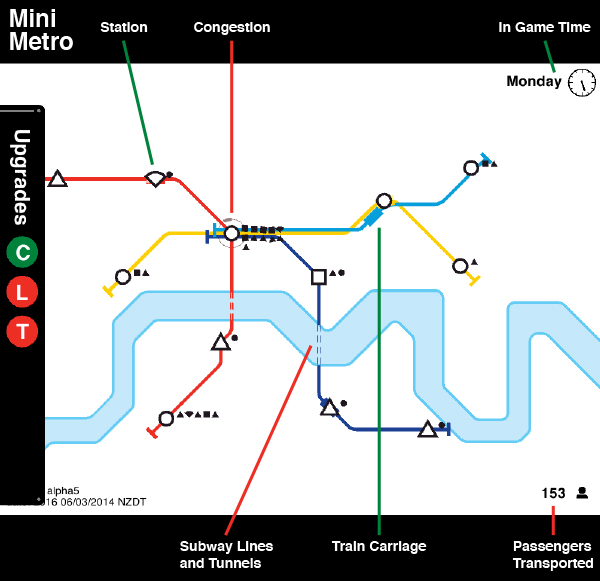Fellow transit nerds, behold a new and brilliantly addicting web-based* game just for you. Mini Metro, inspired by the London Underground and New York City Subway networks, gives you the power to manage your own subway. At first glance, the game may not appear deeply sophisticated, but it is quite dynamic. Players are presented with constant decision points: expansion or contraction of subway lines, additional train capacity, new tunnels, bigger train stations. The ultimate goal of the game is to move as many passengers as possible quickly and efficiently along the subway network.

Key elements for game play:
- Station Nodes—Stations range in type and quality: square, triangle, circle, and special stations. Passengers appear at stations and must be move to a station that matches their symbol. Stations that become too congested will have a countdown circle appear. Congestion must be alleviated before the countdown expires, otherwise the game ends. Station capacity upgrades are offered later in the game.
- Subway Lines—At the start of the game, you can only develop three subway lines. Luckily, these can be rerouted at will to meet changing needs of your network. Subway lines can be interlined, tunnelled under water, and circular.
- Trains—Trains travel from end to end of a subway line, except on circular lines where they loop. There are upgrade options to increase train speed and capacity during the game.
- Game Time—As game time progresses, new passengers and stations are generated. Upgrades are offered at the end of each full week. These upgrades are integral to capacity.
If you become hooked on the game, Greater Greater Washington has some great strategies to game play that may be helpful.
*Developers of Mini Metro plan to launch the game for tablets and computers in the next few months.
Stephen is a professional urban planner in Puget Sound with a passion for sustainable, livable, and diverse cities. He is especially interested in how policies, regulations, and programs can promote positive outcomes for communities. With stints in great cities like Bellingham and Cork, Stephen currently lives in Seattle. He primarily covers land use and transportation issues and has been with The Urbanist since 2014.


